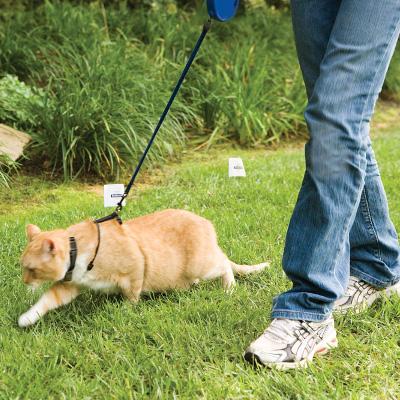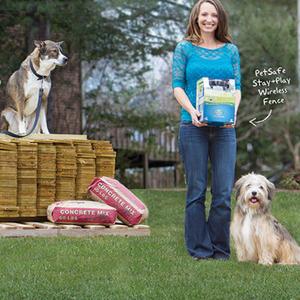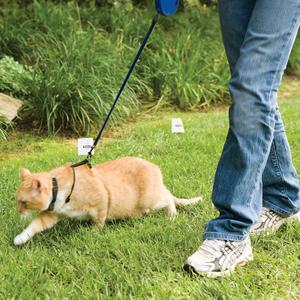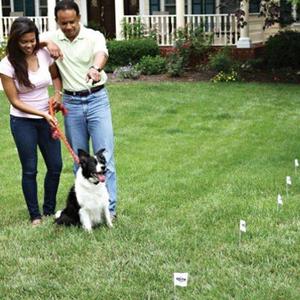Cats never seem to do what we want. They know when you’ve hidden a pill in their food, and they know the best place to nap is on your clean laundry. When you let your cat outside for some fresh air and exercise, you know she doesn’t always stay in your yard. Cats are territorial, and their territory can range from a few houses to a neighborhood block or more.
Keeping your cat contained safely in your yard and not roaming the streets is easy with an in-ground or wireless fence. Just like dogs, cats can use electronic fences too. Some cats even learn their yard boundaries faster than dogs. All it takes is some time and patience and your cat will be enjoying her new safer yard freedom in only a few weeks.
Fit the Collar
-
 Put the collar on your cat. Let her inspect it and get used to the weight.
Put the collar on your cat. Let her inspect it and get used to the weight. - Tighten the collar until you can fit 1 finger between the collar and her neck.
- Trim the extra strap length if it’s too long.
- Make sure the contact points are very close to her skin. You can use long contact points or trim her neck fur if she’s a long-haired cat.
- If the collar seems too heavy or your cat seems uncomfortable, you might need a smaller collar.
- Check the collar fit during your training to make sure it still fits.
- Take off the collar when your cat’s not using it. Just like with standard collars, leaving a receiver collar on for too long can cause irritation.
Get Your Cat Used to the Collar & Practice Leash Walking
 Some cats need a little extra time to adjust to the collar. If your cat hates having the collar on or seems uncomfortable, put on the collar for only a few minutes at a time. Take it off, then reward her with treats and petting. Practice this for a few days until she’s comfortable wearing the collar for longer and longer periods.
Some cats need a little extra time to adjust to the collar. If your cat hates having the collar on or seems uncomfortable, put on the collar for only a few minutes at a time. Take it off, then reward her with treats and petting. Practice this for a few days until she’s comfortable wearing the collar for longer and longer periods.
Teaching your cat to walk on a harness will help with the actual training. You’ll need to be able to control your cat’s movements during fence training, and a harness and leash is the safest way to do this.
Follow the same method as above to get your cat used to wearing a harness. This way you won’t have to struggle to get her outside, let alone get any fence training done.
Basic Flag Training
Once your fence is installed and your cat is comfortable exploring your yard with a harness on, you can start teaching her where her boundaries are.
-
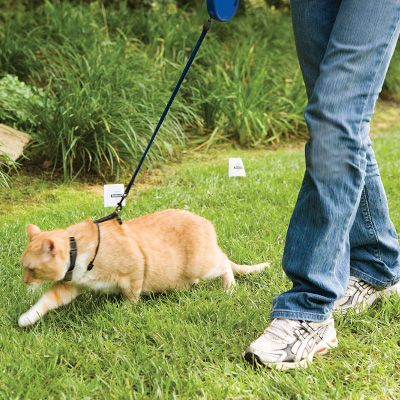 Place boundary flags around the perimeter of your yard to mark your cat’s boundaries.
Place boundary flags around the perimeter of your yard to mark your cat’s boundaries. - Set your cat’s collar to tone only mode.
- Walk your cat towards the flags. When she gets close to the flags, she’ll hear a warning beep from the collar that tells her she’s gotten too close.
- Lead her back into the yard, away from the flags, to teach her not to go past the flags.
- Be ready for your cat to bolt back to the house. Let her run away while holding the leash firmly, but don’t let her go past the boundary flags.
- If your cat doesn’t make the connection between the flag and the beep, hold a flag in your hand and wave it near her when the collar starts to beep. You can also add a command like “Run Away”
- Continue this training for a few days. Training works best in several short, 10-minute sessions a day.
Continued Training to Reinforce Yard Boundaries
Once your cat understands what the flags and beeping mean, repeat the same steps with static correction on.
- Turn the collar to the first level of static correction.
- Walk your cat towards the flags. When she gets close to the flags, she’ll hear a warning beep from the collar that tells her she’s gotten too close.
- Let her go past the flags. She will feel a gentle correction from the collar. It will feel like a mild static shock you get when you walk across a carpet and touch something metal.
- When your cat is corrected, lead her away from the flags. Again, be ready for her to bolt. The correction isn’t painful, but it is surprising, especially for timid cats.
- Continue this training for a few days. Training works best in several short, 10-minute sessions a day.
Supervised Yard Freedom
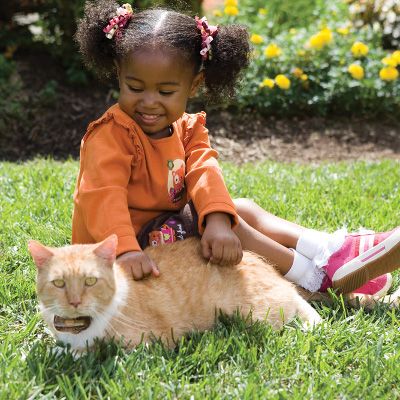 Once she’s mastered the flags and the collar correction, you can let her off the leash and see how she responds to her new outdoor play area.
Once she’s mastered the flags and the collar correction, you can let her off the leash and see how she responds to her new outdoor play area.
- Stay outside with her at first to make sure she understands where she can go and doesn’t try to escape from your yard.
- Leave her outside alone for short periods. Gradually increase the time she spends alone outside.
- Remove the flags from your yard. Take away every other flag from the boundary. Wait a few days before doing the same again.
- Hold onto the flags and keep them for future use. Your cat might need a reminder once in a while, or you might move and take the fence with you.
Outdoor Cat Safety Tips
- When your cat’s outside, make sure she wears a safe breakaway cat collar with updated ID tags.
- Keep your cat’s vaccinations recent and give her monthly parasite prevention medicine.
- Regularly check on your cat when she’s outside.
- Give her an emergency escape route back to the house by installing a cat door where she can access it.

